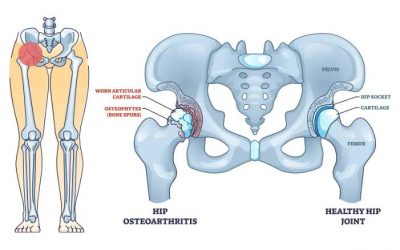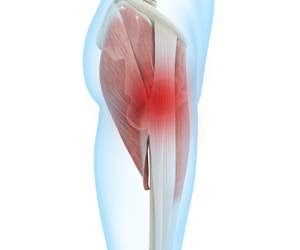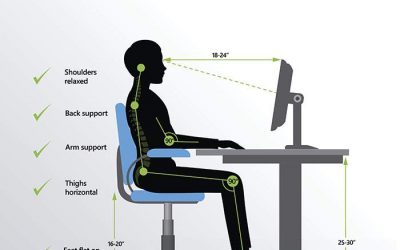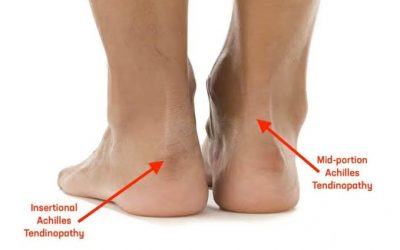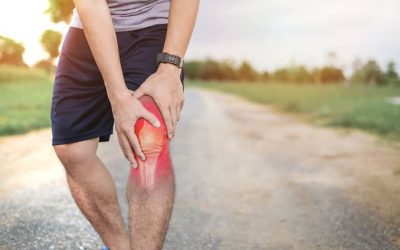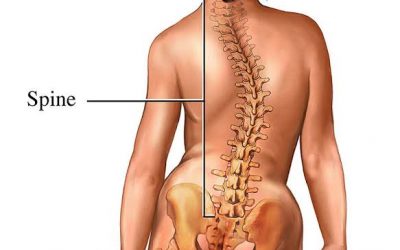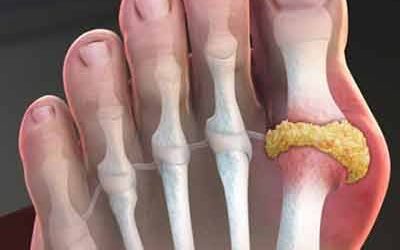

Spinal stenosis is a common condition where the small spinal canal, which contains the nerve roots and spinal cord, becomes compressed. This pinches the nerves and spinal cord, causing pain, cramping, weakness, or numbness affecting the lower back and legs, neck, shoulders, or arms. Anyone over 50 is at risk for spinal stenosis. This condition often occurs due to aging-related changes, such as osteoarthritis or bony spurs. Thickening ligaments in the back or bulging discs are other possible causes. Females, people born with narrow spinal canals, and those who have had previous spinal injuries or surgery are at higher risk. Paget’s disease, spondyloarthritis, and spinal tumors may also cause spinal stenosis.
Causes of spinal stenosis
The most common cause of spinal stenosis is aging. As you age, tissues in your spine may start to thicken, and bones may get bigger, compressing the nerves.
Certain health conditions may also contribute to spinal stenosis. They include:
- Achondroplasia: Achondroplasia is a type of dwarfism that interferes with bone formation in the spine and other parts of the body.
- Ankylosing spondylitis: It is a type of arthritis that causes chronic inflammation in the spine. It can lead to the growth of bone spurs.
- Congenital spinal stenosis: Congenital spinal stenosis occurs when you’re born with a naturally narrow spinal canal.
- Ossification of the posterior longitudinal ligament (OPLL): In this condition, calcium deposits form on the ligament that runs through the spinal canal.
- Osteoarthritis: In osteoarthritis, the cartilage that cushions your joints breaks down. The condition can affect the cartilage between vertebrae and cause bone spurs to grow in the spine.
- Paget’s disease of the bone: Paget’s disease of the bone is a chronic condition that causes bones to get weaker and grow larger than usual.
- Rheumatoid arthritis: It involves chronic inflammation, which can cause bone damage and the development of bone spurs.
- Scoliosis: It is an abnormal curving of the spine. It may result from certain genetic conditions, neurological abnormalities, or unknown causes.
- Spinal injuries: Bone fractures may cause vertebrae or bone fragments to put pressure on the spinal nerves while slipped discs can also put pressure on the spinal nerves.
- Spinal tumors: These tissue growths may develop in the spinal canal, trigger inflammation, and cause changes in the surrounding bone.
Symptoms and complications of spinal stenosis
Early lumbar spinal stenosis may have no symptoms. In most people, symptoms develop slowly over time. Symptoms may include:
- Back pain
- Burning pain going into the buttocks and down into the legs (sciatica)
- Numbness, tingling, cramping, or weakness in the legs
- Loss of sensation in the feet
- A weakness in a foot that causes the foot to slap down when walking. This is also called foot drop.
- Loss of sexual ability
Pressure on nerves in the lumbar region can also cause more serious symptoms known as cauda equina syndrome. If you have any of these symptoms, you need to get medical care right away:
- Loss of bowel or bladder control
- Severe or increasing numbness between your legs, inner thighs, and back of the legs
- Severe pain and weakness that spreads into one or both legs. This makes it hard to walk or get out of a chair.
Diagnosis
Your healthcare professional may ask about your symptoms and medical history. You may have a physical exam. You also may need an imaging test to help find the problem.
Imaging tests
These tests may include:
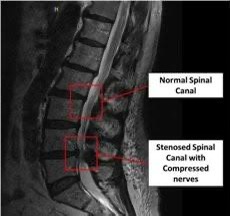
- X-rays. An X-ray of the back can show bone changes that may be making the space within the spinal canal smaller. Each X-ray involves a small dose of radiation.
- Magnetic resonance imaging (MRI). An MRI uses a powerful magnet and radio waves to produce detailed images of hard and soft tissue. The test can detect damage to the disks and ligaments. It also can show whether tumors are present.
- Computerized tomography (CT). If you can’t have an MRI, you may need a CT scan. This test combines X-ray images taken from many different angles. In a CT myelogram, a contrast dye is injected to outline the spinal cord and nerves. This can show herniated disks, bone spurs and tumors.
What Are Common Treatments?
There is no cure for spinal stenosis, but exercise, medications and surgery may relieve symptoms. Regular exercise builds strength in arms and upper leg muscles to improve balance, walking and bending ability, and to ease the pain. A physical therapist may show patients the correct exercises for spinal stenosis. Over-the-counter medications such as acetaminophen, and nonsteroidal anti-inflammatory drugs may relieve pain. Patients with severe or worsening symptoms may need surgery.
Living with Spinal Stenosis
Spinal stenosis may cause slow, steady loss of leg strength, and severe pain that greatly affects a person’s ability to work or enjoy life. Regular exercise is essential to maintain mobility for as long as possible. Start with flexion-based exercises and slowly add walking or swimming to the routine. Modify activities that may cause pain or disability, such as lifting heavy objects or walking long distances. Ask your rheumatologist about pain medications or alternative therapies for pain, such as massage or acupuncture. Explore non-surgical options for pain before surgery, except in rare cases when pain, numbness and muscle weakness come on quickly. People with spinal stenosis should work closely with their doctors to create a treatment strategy, including exercise suggestions and physical therapy.
